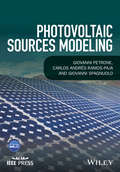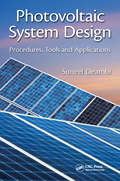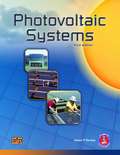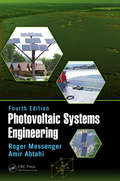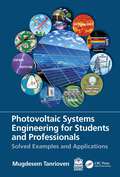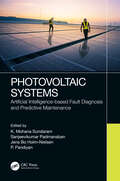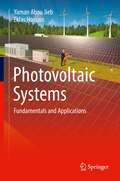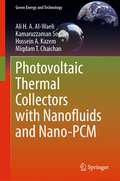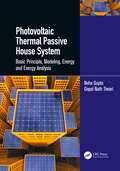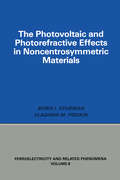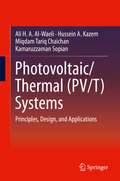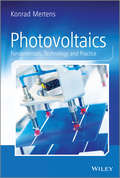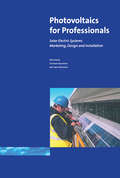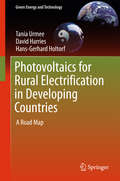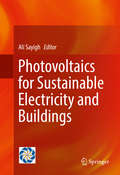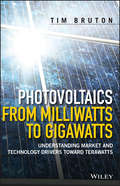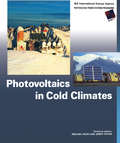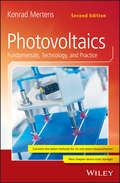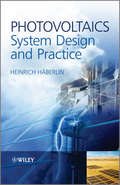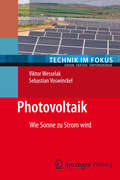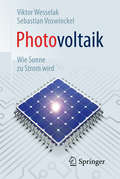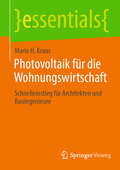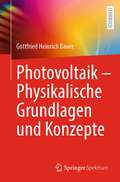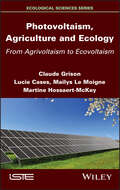- Table View
- List View
Photovoltaic Sources
by Gianpaolo Vitale Maria Carmela Di PiazzaModeling of photovoltaic sources and their emulation by means of power electronic converters are challenging issues. The former is tied to the knowledge of the electrical behavior of the PV generator; the latter consists in its realization by a suitable power amplifier. This extensive introduction to the modeling of PV generators and their emulation by means of power electronic converters will aid in understanding and improving design and set up of new PV plants. The main benefit of reading Photovoltaic Sources is the ability to face the emulation of photovoltaic generators obtained by the design of a suitable equipment in which voltage and current are the same as in a real source. This is achieved according to the following steps: the source electrical behavior modeling, the power converter design, including its control, for the laboratory emulator. This approach allows the reader to cope with the creation of an indoor virtual photovoltaic plant, in which the environmental conditions can be imposed by the user, for testing real operation including maximum power point tracking, partial shading, control for the grid or load interfacing, etc. Photovoltaic Sources is intended to meet the demands of postgraduate level students, and should prove useful to professional engineers and researchers dealing with the problems associated with modeling and emulation of photovoltaic sources.
Photovoltaic Sources Modeling
by Carlos Andrés Ramos-Paja Giovanni Petrone Giovanni SpagnuoloA practical reference to support choosing, customising and handling the best PV simulation solution This comprehensive guide surveys all available models for simulating a photovoltaic (PV) generator at different levels of granularity, from cell to system level, in uniform as well as in mismatched conditions. Providing a thorough comparison among the models, engineers have all the elements needed to choose the right PV array model for specific applications or environmental conditions matched with the model of the electronic circuit used to maximize the PV power production. Key features: Multiple mathematical models are given for different application requirements. The shading effect is taken into account to improve the model accuracy. Procedures for parameter identification of the PV model are analysed and compared. Mathematical manipulations are introduced to some models to reduce their calculation time. The electronic interface effect on the power chain is analysed. Analytical expressions are used to design and control the power converter driving the PV field. The book is an essential reference for R&D in the PV industry; designers of power converters for PV; PV systems designers; and practicing engineers.
Photovoltaic System Design: Procedures, Tools and Applications
by Suneel DeambiIntroducing a Reliable Green Technology That Can Help Improve System Performance Solely centered on photovoltaic (PV) system sizing and the tools used for PV system analysis and design, Photovoltaic System Design: Procedures, Tools and Applications emphasizes the importance of using solar PV technologies for a number of end-use applications, and examines growing interest in solar PV-based projects on a global scale. Written for the system designer/project developer/manufacturer dedicated to correctly sizing a PV system, the book outlines various aspects of PV technology, applications, and programs. It describes key attributes, system design requirements, influence on climatic and site-specific parameters, utilization of simulation procedures, and expected performance. The author includes actual case studies for system designing procedures adopted by various companies and provides a framework for working through both direct and indirect variables under the actual system designing phase. A vital resource essential to your collection, this book: Touches upon the role of renewable energy technologies in a holistic energy scenario Makes a clear categorization of off-grid and on-grid PV applications and discusses advantages and limitations Considers the potential of solar radiation availability Introduces PV system sizing procedures via the modern use of simulation softwares Presents an analysis of actual PV power plant sites when designed via the use of simulation software Determines the weak links in a PV system Brings out the importance of capacity building initiatives vis-à-vis the available range of PV simulation software, tools, and procedures Photovoltaic System Design: Procedures, Tools and Applications provides a clear understanding of the issues that can affect the operation and smooth running of PV facilities and aids in determining photovoltaic system sizing procedures from a variety of end-use considerations. The book encompasses civil, mechanical, electrical, geotechnical, and power systems engineering and is useful to industry professionals involved in solar power plant design.
Photovoltaic Systems
by James P. DunlopPhotovoltaic Systems is a comprehensive guide to the design and installation of several types of residential and commercial PV systems. Numerous illustrations explain the concepts behind how PV arrays and other components operate, and photographs of actual installations show how components are integrated together to form complete systems. This textbook addresses the PV topics included in the NABCEP Entry Level Program. This new edition also covers 2011 NEC® requirements. A CD-ROM is also included with Photovoltaic Systems and contains information to supplement the textbook.
Photovoltaic Systems Engineering
by Roger A. Messenger Amir AbtahiThe primary purpose of PV Systems Engineering is to provide a comprehensive set of PV knowledge and understanding tools for the design, installation, commissioning, inspection, and operation of PV systems. During recent years in the United States, more PV capacity was installed than any other electrical generation source. In addition to practical system information, this new edition includes explanation of the basic physical principles upon which the technology is based and a consideration of the environmental and economic impact of the technology. The material covers all phases of PV systems from basic sunlight parameters to system commissioning and simulation, as well as economic and environmental impact of PV. With homework problems included in each chapter and numerous design examples of real systems, the book provides the reader with consistent opportunities to apply the information to real-world scenarios.
Photovoltaic Systems Engineering for Students and Professionals: Solved Examples and Applications
by Mugdesem TanriovenPhotovoltaic Systems Engineering for Students and Professionals: Solved Examples and Applications examines photovoltaic (PV) power plants in a holistic way. PV installations of all types and sizes – from the smallest plant element to the largest system components – are approached from an electrical engineering perspective and further explained through worked examples. It presents the different forms of energy and the energy conversions between them in a clear and understandable way. This book is an essential resource for both students and practicing engineers working in the solar photovoltaic areas and critical work for all electrical engineers. Features: Includes over 100 worked examples and more than 80 end-of-chapter problems Presents systematic techniques and approaches to problem solving Includes PowerPoint presentations and a solutions manual for instructors Considers the effects of environmental conditions on the performance of PV systems Presents step-by-step design of photovoltaic systems of all sizes from scratch
Photovoltaic Systems: Artificial Intelligence-based Fault Diagnosis and Predictive Maintenance
by Sanjeevikumar Padmanaban Jens Bo Holm-Nielsen K. Mohana Sundaram P. PandiyanThis book provides comprehensive insight into the fault detection techniques implemented for photovoltaic (PV) panels. It includes studies related to predictive maintenance needed to improve the performance of the solar PV systems using Artificial Intelligence (AI) techniques. The readers gain knowledge on the fault identification algorithm and the significance of all such algorithms in real-time power system applications. Gives detailed overview of fundamental concepts of fault diagnosis algorithm for solar PV system Explains AC and DC side of the solar PV system-based electricity generation with real-time examples Covers effective extraction of the energy from solar radiation Illustrates artificial intelligence techniques for detecting the faults occurring in the solar PV system Includes MATLAB® based simulations and results on fault diagnosis including case studies This book is aimed at researchers, professionals and graduate students in electrical engineering, artificial intelligence, control algorithms, energy engineering, photovoltaic systems, industrial electronics.
Photovoltaic Systems: Fundamentals and Applications
by Eklas Hossain Yaman Abou JiebThis textbook provides students with an introduction to the fundamentals and applications of solar photovoltaic systems, connecting the theory of solar photovoltaics and the practical applications of this very important source of energy. Chapters are written concisely in straightforward language that provides clear explanations of the concepts and principles, with an emphasis on humanitarian applications of photovoltaic systems and a focus on relatively small size systems that will make the book relatable to readers. It begins with an introduction and overview of the fundamentals of solar cell fabrication, module design, and performance along with an evaluation of solar resources. The book then moves on to address the details of individual components of photovoltaic systems, design of off-grid, hybrid, and distributed photovoltaic systems, and grid-tied photovoltaic systems based on the National Electrical Code (NEC). Coverage also includes a techno-economic analysis of solar photovoltaics, a discussion of the challenges and probable solutions of photovoltaic penetration into the utility grid, and an exploration of the potential of photovoltaic systems. Photovoltaic Systems: Fundamentals and Applications is designed to be used as an introductory textbook and professional training manual offering mathematical and conceptual insights that can be used to teach concepts, aid understanding of fundamentals, and act as a guide for sizing and designing practical systems.
Photovoltaic Thermal Collectors with Nanofluids and Nano-PCM (Green Energy and Technology)
by Hussein A. Kazem Kamaruzzaman Sopian Ali H. Al-Waeli Miqdam T. ChaichanThis book gives you theory and design of PV/T systems. Are you interested in solar energy? If you are, you must have read about solar panels, or photovoltaics (PV). If you have installed a photovoltaic system, you must have noticed it not to generate the amount of power mentioned in its datasheet. A major issue that PV suffers from is its temperature, which causes a drop in its power. Among the solutions to this issue is to use active cooling methods, such as the hybrid photovoltaic thermal (PV/T) system. These systems can produce electrical and thermal energy simultaneously and within same area. The thermal collector serves to cool down the PV surface temperature, which negatively affects the PV efficiency, to reclaim the efficiency or bring it back close to standard testing conditions value. Moreover, the thermal collector will convey this heat using a working fluid and extract it as thermal energy. On the other hand, the electrical power generated from the PV can be utilized in standalone or grid-connected configuration. Moreover, the book presents a novel PV/T collector which can utilize nanofluids and nano-Phase Change Material (PCM) to enhance its performance in tropical climate conditions. The methods used to develop the heat transfer and energy balance equations are presented as well. PV/T collector numerical simulation using MATLAB and computational fluid dynamic (CFD) was also presented. Finally, the approach of life cycle cost analysis (LCCA) is presented to evaluate PV/T with nanofluid and nano-PCM, economically.
Photovoltaic Thermal Passive House System: Basic Principle, Modeling, Energy and Exergy Analysis
by Neha Gupta Gopal Nath TiwariSustainable Advanced Solar Passive House provides a platform to disseminate knowledge regarding the basics of solar energy, heat transfer, and solar houses, including designing concepts. Apart from a brief introduction to solar physics and thermodynamics, the book primarily deals with the technical description of solar houses and associated concepts. Different types of photovoltaic modules and their integration with the buildings are discussed with case studies, including energy balance equations and fundamental energy matrices. It discusses concepts like energy matrices, solar passive heating/cooling, architecture design, low-cost building, energy/exergy analysis, building integrated photovoltaic, and energy conservation.
Photovoltaic and Photo-refractive Effects in Noncentrosymmetric Materials
by Boris I. Sturman Vladimir M. FridkinFerroelectric materials, in addition to possessing the unique property of a reversible, spontaneous polarization, exhibit a range of other significant and useful properties. These include high values of piezoelectric, pyroelectric, nonlinear optic, electrooptic, photorefractice and dielectric permittivity coefficients. Another fascinating property of ferroelectric materials is their photovoltaic effect. Photovoltaic effects have been extensively studied in the past in symmetric materials such as silicon. This volume is the first concentrated treatment of the characteristics, theory and potential applications of the photovoltaic effect in noncentrosymmetric materials, which include ferroelectrics and piezoelectrics. The book also deals with the relationship between the photovoltaic and the photorefractive effects. The latter has already been well-studied and is finding many applications in optical processing and computing. This volume should prove to be an important text as well as a comprehensive reference source for basic and applied researchers working on photovoltaic, photorefractive and other photoeffects in ferroelectrics and related materials.
Photovoltaic/Thermal (PV/T) Systems: Principles, Design, and Applications
by Miqdam Tariq Chaichan Hussein A. Kazem Kamaruzzaman Sopian Ali H. Al-WaeliThis book provides the most up-to-date information on hybrid solar cell and solar thermal collectors, which are commonly referred to as Photovoltaic/Thermal (PV/T) systems. PV/T systems convert solar radiation into thermal and electrical energy to produce electricity, utilize more of the solar spectrum, and save space by combining the two structures to cover lesser area than two systems separately. Research in this area is growing rapidly and is highlighted within this book. The most current methods and techniques available to aid in overall efficiency, reduce cost and improve modeling and system maintenance are all covered. In-depth chapters present the background and basic principles of the technology along with a detailed review of the most current literature. Moreover, the book details design criteria for PV/T systems including residential, commercial, and industrial applications. Provides an objective and decisive source for the supporters of green and renewable source of energy Discusses and evaluates state-of-the-art PV/T system designs Proposes and recommends potential designs for future research on this topic
Photovoltaics
by Konrad MertensConcise introduction to the basic principles of solar energy, photovoltaic (PV) systems, PV cells, PV measurement techniques, and grid connected systems, overviewing the potential of PV electricity for students and engineers new to the topic Starting with the basic principles of solar energy, this practical text explains the fundamentals of semiconductor physics and the structure and functioning of the solar cell. It describes current measurement techniques for solar modules, and the planning and operation of grid-connected and off-grid PV systems. Key features: clarifies the technical and economic perspectives of PV energy generation, whilst providing an overview on the current economic statusdiscusses the future development of PV, including efficient promotion instruments and price developmenteach chapter contains various exercises and descriptive examples, with operation results from concrete PV plantsan accompanying website hosting exercise solutions, links to further PV references, and free downloads of the figures and additional software www.textbook-pv.orgThis is an essential text for renewable energy students, technicians and engineers wanting to know how solar cells work and how to design a complete PV plant. It is also a useful resource for PV installers, planners, operators, consultants, financers, potential energy investors and politicians.
Photovoltaics for Professionals: Solar Electric Systems Marketing, Design and Installation
by Antony Falk Christian Durschner Karl-Heinz RemmersFor the building industry, the installation of photovoltaic systems has become a new field of activity. Interest in solar energy is growing and future business prospects are excellent. Photovoltaics for Professionals describes the practicalities of marketing, designing and installing photovoltaic systems, both grid-tied and stand-alone. It has been written for electricians, technicians, builders, architects and building engineers who want to get involved in this expanding industry. It answers all the beginner's questions as well as serving as a textbook and work of reference, provides designers and installers with practical specialist knowledge needed to design and install high quality solar electric systems and gives a comprehensive overview of the major photovoltaic market sectors. Photovoltaics for Professionals contains over 100 full colour illustrations and covers: Marketing and promoting photovoltaics Solar cells, PV modules and the solar resource Grid-tied PV systems Stand-alone PV systems Practical step-by-step examples are described of how to go about installing systems right from the first customer contact and many useful tips are given to help avoid mistakes.
Photovoltaics for Rural Electrification in Developing Countries
by Tania Urmee David Harries Hans-Gerhard HoltorfThe evidence suggests that many solar programs are being designed and implemented in isolation and without reliance on published guidelines or the experience gained by others. The conclusion is obvious: the likelihood of a program being successful would be greatly improved if program implementers were made more aware of best practice guidelines and of the lessons and experience learned by others in implementing previous programs. Furthermore, the best practice guidelines not only need to be readily available but need to describe the stages, issues and the stakeholders' roles in designing and implementing a SHS program. This book showcases a detailed road map that has been developed for the implementation of rural electrification projects in developing countries using solar PV. Features of this book will be case studies derived from personal participatory observation of the authors on Solar Home Systems, their impact, their advantages and disadvantages and their operation.
Photovoltaics for Sustainable Electricity and Buildings
by Ali SayighThis leading-edge volume on advances in photovoltaic technology features diverse contributions from experts in every major geographic PV market. It examines emerging applications such as electricity grid load-balancing and demand- response, PV storage systems, photovoltaic/thermal solar collectors and carbon-offset in buildings. Engineers, researchers, developers and students alike will find new avenues for exploration and fresh insights into this continually evolving field. Highlights the most recent advances in Photovoltaics, from Next-Gen Storage Systems to Bifacial PV/T Solar Collectors; Provides expert insights on the recent evolution and near future of PV markets around the globe; Covers applications from grid-tied storage and power generation to green buildings.
Photovoltaics from Milliwatts to Gigawatts: Understanding Market and Technology Drivers toward Terawatts
by Tim BrutonAn essential guide through the rapid evolution of PV technology Photovoltaics from Milliwatts to Gigawatts: Understanding Market and Technology Drivers toward Terawatts covers the history of silicon based PV, from the earliest discoveries to present and future practice. Divided into 9 chapters, the book includes the following topics: Early History; The 1973 Oil crisis and the drive for alternative energies; The emergence in the 1980’s of the off grid PV market, the significant small scale PV consumer market and the establishment of a manufacturing industry; Advantages of silicon for solar cells; The evolution of PV installations; The history of the incentive programme for PV; Difficulties of alternative technologies in challenging silicon dominance; Current status of the silicon manufacturing technology and The future. Key features: An authoritative first-hand account of an emerging technology from laboratory to global significance for electricity generation by an industry expert. Provides a framework for policy makers on future trends in the PV industry. Examines the lessons learnt from the interaction of research laboratories, major industry and government. Signposts the route to future high efficiency silicon solar cells giving new researchers a background for further development. Highlights the critical success factors for the emerging alternative manufacturing technologies. An essential PV guide aimed at researchers and students in electrical engineering and physical sciences through the rapid evolution of PV technology to commercial viability and the challenges ahead for increased performance, efficiency and global deployment.
Photovoltaics in Cold Climates
by Jimmy Royer Michael RossProviding electric power to remote, cold regions at high latitude or altitude can be an expensive and technically challenging task. Photovoltaics (PV) provide a reliable and cost-effective solution yet their potential is underdeveloped, in part because of a lack of knowledge about their effectiveness in cold climates. This book illustrates the potential and the techniques for using PV in cold climates. The book starts with a general section illustrating how PV can be applied in cold climates, with a succinct overview of the main considerations and chapters covering both the solar resource and the economics. It then covers the effects of cold climates on PV systems looking at the issues around the array and electronics, the battery and energy management. The third section covers design considerations and possible configurations (stand alone/battery systems, hybrid systems, seasonal storage and system simulation). The next part covers installation and operation and the book concludes with several case studies. The book will be invaluable both for all managers charged with providing power to cold climates whether for dwellings, other buildings or technical installations and for all technicians, engineers, installers and researchers working on such installations. It will also be of great interest to those working with PV in any form, or interested to see PV technology reach its full potential.
Photovoltaics: Fundamentals, Technology, and Practice
by Konrad MertensA comprehensive tutorial on photovoltaic technology now fully updated to include solar storage and the latest methods for on-site plant measurements Starting with the basic principles of solar energy, this fully updated, practical text explains the fundamentals of semiconductor physics and the structure and functioning of the solar cell. It describes the latest measurement techniques for solar modules, and the planning and operation of grid-connected and off-grid PV systems. It also looks at other thin film cells, hybrid wafer cells, and concentrator systems. Additionally, this Second Edition covers solar modules and solar generators; system technology of grid connected plants; the storage of solar energy; photovoltaic measurement technology; the planning and operation of grid-connected systems; economic efficiency of PV systems; and the future development of PV. Presents the latest advances in PV R&D and industry deployment Updated illustrations and tabular data reflect current state-of-the-art and PV technology efficiencies Offers expanded tutorial sections to aid teaching and self-study Includes a brand-new chapter on Solar Energy Storage Features two enlarged chapters—one on up-to-date photovoltaic metrology and the other on the future developments in photovoltaics Comes along with the accompanying website www.textbook-pv.org which offers free downloadable figures of the book, solutions of exercises, additional free PV software etc. Developed to prepare engineering students for the PV industry, this practical text is an essential PV primer.
Photovoltaics: System Design and Practice
by Heinrich HäberlinWith the explosive growth in PV (photovoltaic) installations globally, the sector continues to benefit from important improvements in manufacturing technology and the increasing efficiency of solar cells, this timely handbook brings together all the latest design, layout and construction methods for entire PV plants in a single volume.Coverage includes procedures for the design of both stand-alone and grid-connected systems as well as practical guidance on typical operational scenarios and problems encountered for optimum PV plant performance. This comprehensive resource will benefit electrical engineer and other electrical professionals in PV systems, especially designers and installers of PV plants or the product manufacturing and testing supply chain. Advanced students on renewable energy courses will find this useful background reading and it will be an invaluable desk reference for PV plant builders and owners.
Photovoltaik
by Viktor Wesselak Sebastian VoswinckelWie funktioniert Photovoltaik? Welche Arten von Solarzellen gibt es? Wie wirtschaftlich sind Photovoltaik-Anlagen? Die Autoren erklären die wichtigsten Eigenschaften der Sonnenstrahlung und vermitteln die prinzipielle Funktionsweise einer Solarzelle. Sie gehen auf die Unterschiede heutiger und zukünftiger Technologien ein und diskutieren die Wirtschaftlichkeit unterschiedlicher Anlagenkonzepte. Dadurch finden Leser einen schnellen Einstieg ins Thema und lernen unterschiedliche Technologien und Anlagenvarianten einzuordnen und zu beurteilen.
Photovoltaik - Wie Sonne zu Strom wird
by Viktor Wesselak Sebastian VoswinckelWie funktioniert Photovoltaik? Welche Arten von Solarzellen gibt es? Wie wirtschaftlich sind Photovoltaikanlagen? Wie sieht die zuk#65533;nftige Entwicklung aus? Das kompakte Buch vermittelt fundiertes Orientierungswissen #65533;ber Funktionsweise, Anwendung und Grenzen der Photovoltaik. Es eignet sich f#65533;r einen schnellen Einstieg in die Problematik und erm#65533;glicht eine Einordnung unterschiedlicher Technologien und Anlagenvarianten. Die Autoren erkl#65533;ren anschaulich die wichtigsten Eigenschaften der Sonnenstrahlung und vermitteln die prinzipielle Funktionsweise einer Solarzelle. Sie gehen auf die wesentlichen Unterschiede heutiger und zuk#65533;nftiger Technologien von Solarzellen ein. In der 2. Auflage gehen die Autoren auf die aktuellen Entwicklungen des EEG ein und stellen die Wirtschaftlichkeit unterschiedlicher Anlagenkonzepte mit und ohne F#65533;rderung anhand praxisnaher Beispiele dar.
Photovoltaik für die Wohnungswirtschaft: Schnelleinstieg für Architekten und Bauingenieure (essentials)
by Mario H. KrausDie kurze Einführung in die Photovoltaik erleichtert die ersten Schritte bei der Planung einer PV-Anlage. Die wichtigsten Schwerpunkte werden beschrieben, Rechtsgrundlagen und Risikofaktoren benannt. Ein ausführliches Verzeichnis von Literatur und weiteren Quellen ist enthalten.
Photovoltaik – Physikalische Grundlagen und Konzepte
by Gottfried Heinrich BauerDieses Lehrbuch beschreibt die Prinzipien und Konzepte der quantenhaften Solarenergiewandlung, der Photovoltaik, konsistent mit physikalischen Formulierungen.Beginnend bei den Grundlagen zur Strahlungsquelle Sonne und den theoretischen Grenzen bei der Wandlung solarer Strahlung, über die grundlegenden Prinzipien der Photovoltaik bis zu realen Solarzellen und möglichen Konzepte zur Erhöhung der Ausbeute, ermöglicht das Buch einen Überblick über dieses, auch mit Blick auf eine dauerhafte und klimaneutrale Energieversorgung relevante Thema.Zum Verständnis der Wirkungsweise und der thermodynamischen Limits sind Kenntnisse und Beziehungen aus verschiedenen Gebieten der Physik notwendig, wie Festkörper- und Halbleiterphysik, Thermodynamik und Statistik, Optik und Elektrodynamik. Diese Beziehungen werden zur Erklärung der Funktion von Solarzellen in den vorliegenden Kapiteln im Vergleich mit bestehenden Werken sehr ausführlich dargestellt und in einem Anhang für interessierte Leserinnen und Leser vertieft.Der Inhalt dieses Buchs richtet sich dabei vornehmlich an Studierende im Bachelor- und Masterstudiengang von Natur- und Ingenieurwissenschaften, beispielsweise der Fachrichtungen Physik, Chemie, Umweltwissenschaften, Elektrotechnik und Informatik.
Photovoltaism, Agriculture and Ecology: From Agrivoltaism to Ecovoltaism
by Martine Hossaert-McKey Claude Grison Lucie Cases Mailys Le MoigneOne of the challenges of our modern society is to successfully reconcile growing energy demand, demographic and food pressure and ecological and environmental urgency.This book offers an update on a rapidly evolving subject, that of modern photovoltaic systems capable of combining the needs of energy and ecological transition. Although photovoltaic solar energy is a well-proven technical solution in terms of energy, its development can compete with agricultural land or natural sites.New solutions are emerging: the installation of photovoltaic parks on industrial wasteland; agrivoltaics, which reconcile agricultural activity and energy production on the same surface; and ecovoltaics, which make it possible to make use of the unused surfaces under solar panels by developing ecological solutions capable of providing services to nature. These innovations are part of the response to the need to preserve terrestrial and aquatic ecosystems, halt the decline in animal and plant biodiversity and participate in the development of a new mode of sustainable development and green economy.

